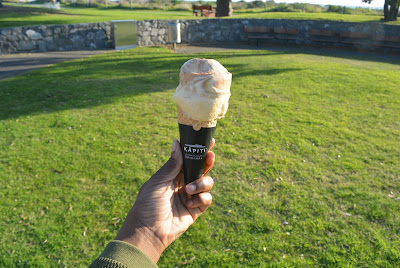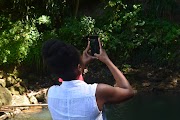It might be soon to call myself a musician. However, as I grow beyond an appreciation for music to a sensing and interpretation of sound, the world itself appears different. Something as simple as hearing Vivaldi's "Four Seasons" salsified has awakened my curiosity. What else have I been missing? Which switches need to flipped and how can I do so? And like many unsolved questions, they were suddenly answered on this trip.
I think everyone has a bucket list of places to visit once coming to New Zealand. I've never encountered a country that spewed natural beauty from every crevice. An Gen Xer may describe it as instagrammable or reelworthy but there are feelings here that a camera simply cannot capture. Trust me I have tried using a couple of the trending reels but it never does it justice. So why did I think this location would be any different.
New Zealand apparently has almost as many islands as the Caribbean (her 600 vs our 700). Kapiti Island is one of the smaller islands just off the coast of the Wellington Region, as small as 10km (6 miles long). It's mainly known as a bird sanctuary and conservation center and is home to New Zealand's oldest species of flora and fauna.
Our guide, Cindy, explain that the breaking of New Zealand from its initial continental mass is the main reason for its composition. The only mammals which made the transition was three different species of bats, one of which is now extinct. It's also the reason that New Zealand is absent of snakes whereas Australia is home to the world's most poisonous. As animals were gradually introduced to the island, it was easier to maintain a less predatory environment in the space now known as Kapiti.
 |
| Weka |
Since most of my travelling companions were Wildlife Conservation enthusiasts, they were already familiar with the necessary taxonomy, so I've already forgotten most of them. I will not, however, forget their cheekiness. For animals which have limited encounter with humans, they sure knew how to express their needs. As soon as Cindy warned us not to feed the birds, the friendly Weka that greeted us earlier, started pecking her poster in obvious protest.
 |
| Takahe |
We also came across cordoned areas which were being used to rehabilitate the Takahe With only 2 couples in existence, they were under careful study and preservation, provided with food and protection. Due to a storm earlier this year, Rachel and Rodney lost their only chick and possibly only chance of future generations. So precautionary measures were stricter than ever.
The aim of the day was to reach the summit of the island. Although 5 km high, there were two options, the trig route or the more accessible Wilkinson Track . If it's one thing I know about hiking is my limits. There was no way I would risk passing out alone so I chose the easier path. I struggled, no joke. I felt the tiredness in my throat and needed to stop every 5 mins. Although there were many scenic spots along the way, I was honestly discouraged and thought I would never make it to the top.
 |
| Robin |
That's when I took a seat and began to listen. I realized that each bird's call was distinct as it was beautiful. Some light and chirpy, the obvious inspiration to Vivaldi's Spring. Others more rustic and reminiscent of eagles. Our guide's experience ears could all but translated their speech. But on my own, I simply enjoyed the opportunity to eavesdrop.
But it's more that the chordal. It's the rustling of leaves, the distant waves and the crunching of stones all supported by a stillness. Even the hikers knew to maintain the serenity of the forest, albeit heavy breathing.
 |
| Bellbirds |
During that break, I found the clarity to keep moving. The wisdom to understand that simply one foot in front of the other was enough the make it up the hill. In no time, I reached the bird feeder, set up for the Hihi birds but unfortunately overtaken by the bellbirds. This means that the Hihi are even closer to extinction but alas that is the law of nature. The bellbirds were so quick that the fastest shutter speed couldn't capture them. The family near me joked that birds weren't meant to actually be in the photo.
I was warned about Haka birds swooping in and unzipping bags but thankfully that didn't happen. They are as large as my head and the last thing I wanted to encounter on my own. We were told about the Saddleback, Kolkata and Kaneki but everyone seemed to be hiding but the Tui. Which is as regular as a seeing a pigeon on the Carenage.
Even though the hill became steeper, I finally managed to find a comfortable pace. Added to that, I was able to encourage myself without any more landmarks to look for. Soon enough I met my friends at the intersection of the trig and got the push I needed to reach the summit.
The closest I've come to a summit view is the Mt. Qua Qua and Welcome Rock. But the summit of an island is a whole different view. Since the island is only 1.2 miles wide (2km), it's a sharp drop to the ocean below on the other side. Which is probably great for the birds but quite scary for any hiker.
The beautiful thing about Kapiti is that it's not just about the birds. My new friends even got to snorkel along the coast and spotted a human length stingray. Once the cold water touched my toes, my wet suit less self resigned to collecting shells along the shore. First it was ordinary stones that had been sanded smooth. Then beautiful snails with iridescent ripples in their shells. Until a rainbow caught my eye. The most beautiful pieces of Paua shell buried between the wet sand.
I can't explain my join to find them and then my sadness to be told that I could keep them. But rules are rules. And so all the memoirs of my trip were sweat, pictures and memories.
Highlights
Transport
The boats are so light that they need to be placed in the water with a large tractor which also enters the water. On our return, we were lucky to be pulled in by Janet, wife of the general operator and give her a great applause for her efforts. I'm yet to understand the mechanics that allow a tractor to enter the water but it sure is efficient.
Plants
The Maori who first lived on this island survived by understanding the islands resources. By using plant to write and mark their path as well as for medicine they maintained a respect for the environment that is to be admired. Many of these plants are endemic to NZ.
The flax seems to be the most useful. The tui feed on the flower's nectar, leaves for straw - harvested the oldest first and the goo can be applied as an antiseptic.
Kawa is considered a hippies plant and healer of all ailments.
Ice cream
One cannot come to Kapiti and not have Kapiti ice cream. There was no official outlet but we enjoyed the open serve at a nearby shop. The Affogato inspired scoop was a beautiful blend of espresso and vanilla. The nectarine was blissfully and pleasantly citrus. They have obviously mastered cream stim I'm not sure I will ever enjoy Haagen Dazs again.































